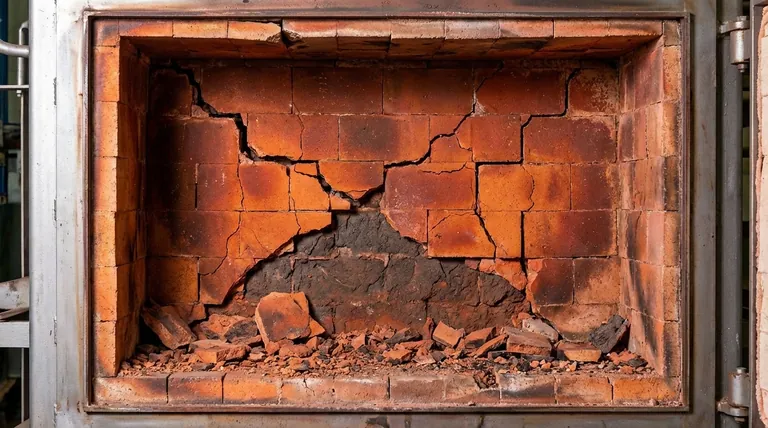The most common cause of furnace lining failure is thermal stress, which manifests as spalling. This occurs because the refractory materials used for the lining expand when heated and contract when cooled. When these changes happen too quickly or unevenly, immense internal pressures build up, causing the material to crack, flake, and break apart.
The core issue is a fundamental conflict in physics: different materials expand and contract at different rates. The inability to manage the stress created by this thermal movement is what ultimately destroys the furnace lining.

The Mechanics of Thermal Stress Failure
To prevent failure, it is essential to understand the sequence of events that leads from simple heating to a structural breakdown of the refractory lining.
Understanding Thermal Expansion
All materials change in volume in response to temperature. In a furnace, the refractory bricks, mortar, and the outer steel shell all grow as they heat up. This physical change is known as thermal expansion.
The Mismatch Problem
The critical issue is that the refractory lining and the steel furnace shell expand at different rates. This differential creates immense mechanical stress. The lining is compressed on heat-up and put under tension on cool-down, effectively trying to tear itself apart from the inside.
From Stress to Cracks
Refractory materials are strong under compression but are brittle and weak under tension. When the internal stresses from thermal expansion exceed the material's inherent strength, microscopic cracks begin to form.
The Definition of Spalling
Spalling is the direct, visible result of this internal stress. It is the process where pieces of the refractory surface break off, flake away, or separate from the main lining. This is the most common failure mode directly linked to thermal conditions.
Key Triggers for Spalling
While thermal expansion is the underlying cause, certain operational conditions can dramatically accelerate the failure of the lining.
Rapid Temperature Changes
Heating or cooling a furnace too quickly is the primary trigger for failure. This creates a steep temperature gradient where the "hot face" of the lining expands much faster than the cooler layers behind it, maximizing internal stress. This phenomenon is known as thermal shock.
Improper Installation
A furnace lining must be installed with strategically placed expansion joints. These are small, engineered gaps that allow the refractory material to expand without building up destructive pressure. If these joints are missing, incorrectly sized, or filled with debris, failure is almost inevitable.
Material Selection
Using a refractory material that is not suited for the furnace's specific operating temperatures and cycle times is a foundational error. A material with a high coefficient of thermal expansion will be more susceptible to spalling in a rapidly cycling furnace.
Understanding the Trade-offs
Managing a furnace lining always involves balancing competing priorities. Understanding these trade-offs is key to making informed operational decisions.
Performance vs. Durability
High-density, highly conductive refractories often offer excellent performance but can be more rigid and prone to thermal shock. Lighter, more insulating materials may handle thermal stress better but can be more susceptible to mechanical wear and chemical attack.
Speed vs. Lifespan
A faster heat-up and cool-down cycle increases production throughput but places significantly more stress on the lining, shortening its lifespan. A slow, controlled temperature change preserves the lining but reduces operational efficiency. This is a constant operational compromise.
Cost vs. Reliability
Investing in premium refractory materials with superior thermal shock resistance has a higher upfront cost. However, this initial expense can prevent far more costly unplanned shutdowns, repairs, and lost production in the long term.
How to Mitigate Lining Failure
Your approach to preserving your furnace lining should be guided by your primary operational goal.
- If your primary focus is maximizing uptime: Implement strict, controlled heat-up and cool-down schedules to minimize the risk of thermal shock.
- If your primary focus is extending lining lifespan: Prioritize correct material selection for your specific application and ensure meticulous installation with adequate expansion joints.
- If your primary focus is proactive maintenance: Conduct regular visual inspections to identify and repair minor cracks before they propagate and lead to large-scale spalling.
Ultimately, mastering the forces of thermal expansion is the key to ensuring the reliability and longevity of any high-temperature furnace lining.
Summary Table:
| Factor | Impact on Lining | Common Result |
|---|---|---|
| Rapid Temperature Changes | High thermal stress | Cracking and spalling |
| Improper Expansion Joints | No room for material expansion | Structural failure |
| Incorrect Refractory Material | Mismatched thermal properties | Accelerated wear and tear |
Protect your furnace investment and maximize uptime with KINTEK.
Thermal stress and spalling don't have to dictate your furnace's lifespan. KINTEK specializes in high-performance lab furnaces and consumables, engineered with durable refractories and precise designs to withstand rigorous thermal cycling. Our experts can help you select the right equipment and provide guidance on optimal operation to prevent lining failure.
Let us help you achieve:
- Longer Lining Lifespan: Reduce costly downtime and repairs.
- Improved Process Reliability: Maintain consistent, high-quality results.
- Expert Support: Get tailored advice for your specific application.
Contact KINTEK today for a consultation and ensure your lab operations run hotter, longer, and safer.
Visual Guide

Related Products
- Electric Rotary Kiln Pyrolysis Furnace Plant Machine Calciner Small Rotary Kiln Rotating Furnace
- Vacuum Sealed Continuous Working Rotary Tube Furnace Rotating Tube Furnace
- Precision Machined Yttria Stabilized Zirconia Ceramic Plate for Engineering Advanced Fine Ceramics
- High-Purity Titanium Foil and Sheet for Industrial Applications
- Graphite Vacuum Continuous Graphitization Furnace
People Also Ask
- What are the products of pyrolysis of wood? A Guide to Biochar, Bio-oil, and Syngas Yields
- What is the principle of rotary kiln? Mastering Continuous Thermal Processing
- What biomass is used in pyrolysis? Selecting the Optimal Feedstock for Your Goals
- What are the zones in rotary kiln in cement production? Master the Core Process for High-Quality Clinker
- What is the difference between calcining and roasting? A Guide to High-Temperature Processing



















